Premier Ingredients
ParActin QuantumActiv™

Explore
The Problem of Pain…
Approximately 25% of adults in the United States experience chronic pain that can interfere with daily activities. Common types of pain include arthritis, backaches, muscle aches, and neuropathies.
Pain may be caused by inflammation or dysfunctional nerves. Neuropathic pain arises from a damaged nerve or impaired central nervous system (CNS), which is comprised of the brain and spinal nerves. The spinal nerves carry pain signals from the body to the brain via sodium and calcium channels. Accumulation of excessive sodium or calcium channels can lead to spontaneous firing of sensory nerves, resulting in prolonged chronic pain.
Prescription medications include anticonvulsants, corticosteroids, muscle relaxers, nerve blocks, NSAIDs, and opioids, all of which tend to have many undesirable side effects. Membrane-stabilizing medications include local anesthetics, steroids, and anticonvulsants,
which block sodium and calcium channels in nerve cells, reducing the pain signaling.
QuantumActiv™ ParActin® is a natural calcium channel blocker that provides powerful, fast-acting joint and muscle comfort without a prescription. The patented QuantumActiv™ skin delivery system effectively penetrates the skin to quickly deliver targeted relief when applied to affected areas.
This FDA-approved topical analgesic contains 1.5% menthol for the temporary relief of minor aches and pains of sore muscles and joints, associated with arthritis, backaches, strains, bruises, sprains, and sports injuries. Continued use of the product may significantly help to increase range of motion, flexibility, and mobility.
QuantumActiv™ ParActin® Instant Pain Relief Cream can be marketed as a pre-workout and post-workout sport cream without menthol. When applied 15 minutes prior to exercise or strenuous activities, the product improves range of motion and flexibility, and helps to reduce sprains, muscle aches, and sport injuries.
ParActin®’s inflammation-management activity comes through its proven ability to switch on the PPAR-gamma receptor, which inhibits an inflammatory molecule, NF-kB, the key regulator of our immune response system.
This reduces a family of pro-inflammatory cytokines such as IL-1b, IL-6, TNF-a, COX-2 and iNOS. Research has shown that ParActin® can selectively block voltage-operated calcium channels and inhibit the entry of Ca(+2) influx, thereby reducing the firing of pain sensation in the neurons.
which block sodium and calcium channels in nerve cells, reducing the pain signaling.

QuantumActiv™ is formulated with a patented photoexcitation technology that improves the skin penetration of ParActin® to promote membrane stabilization by blocking the calcium channels. Rats fed with 1000 mg/kg of APE had average writhing number of 67.22%, comparable to ibuprofen group 58.09%. This result suggests high efficacy of APE in suppressing peripheral pain.
5 Times More Potent In COX-2 Inhibition
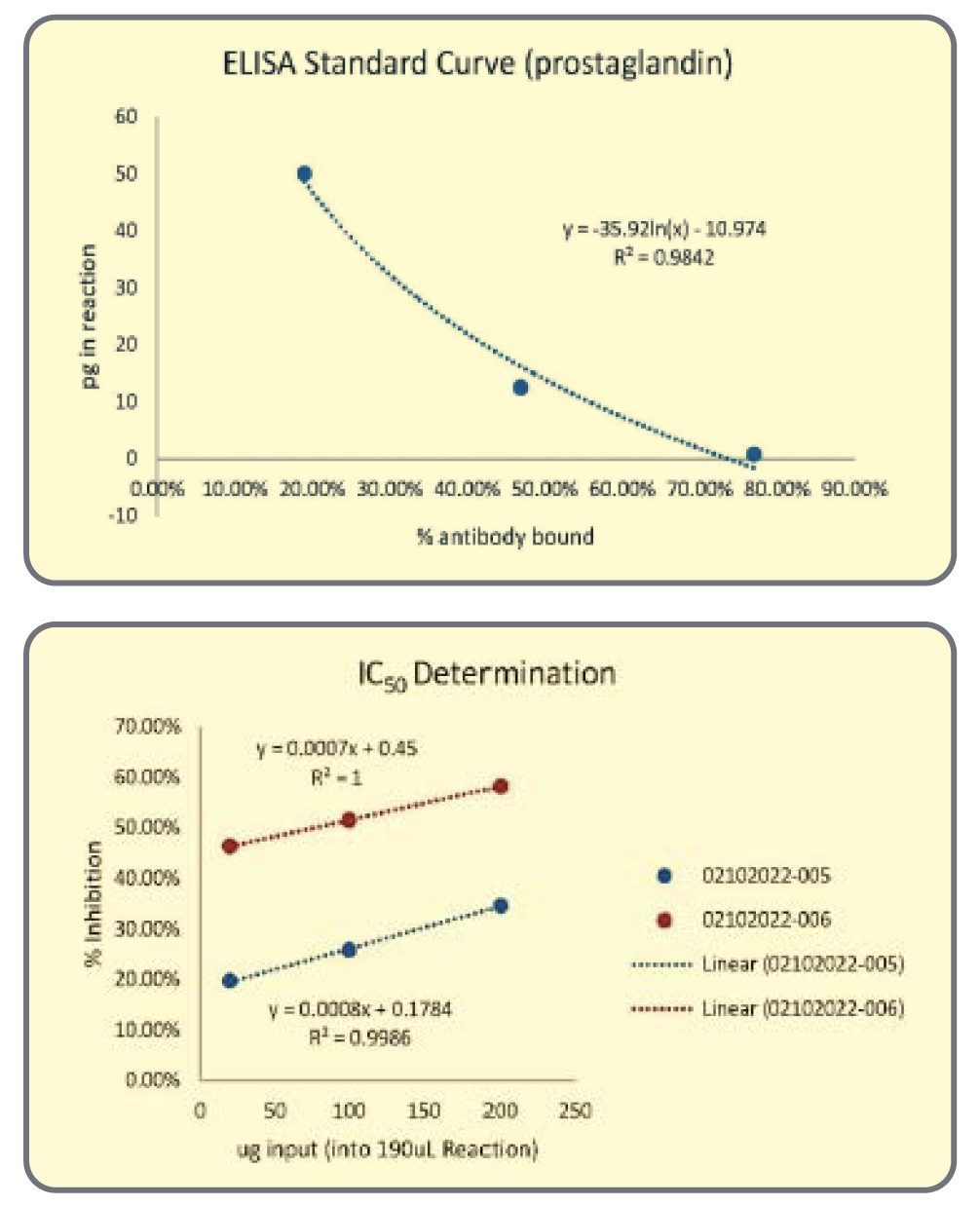
ParActin® showed IC50 of 388 mcg and QuantumActiv™ ParActin® at 76 mcg indicating that the QuantumActiv™ ParActin® is about 5X more potent in COX-2 inhibition than the unactivated ParActin. IC50 % inhibitor = concentration that causes 50% inhibition of COX-2.
Andrographis paniculata Extract Relieves Pain and Inflammation in Monosodium
Iodoacetate-Induced Oesteoarthritis and Acetic Acid-Induced Writhing in Animal Models
Experimental osteoarthritis (OA) was induced in rats with a knee injection of Monosodium Iodoacetate (MIA). Andrographis paniculata extract (APE) substantially reversed the loss of hind limb weight-bearing in the rats, which translates to a pain-relieving effect in the osteoarthritic knees. In addition APE prevented cartilage damage resulted from
the OA induction in rats.
These results are comparable to indomethacin. Acetic acid-induced writhing is used to evaluate analgesic effects of APE and to quantitatively measure inflammatory pain.
Rats fed with 1000 mg/kg of APE had average writhing number of 67.22%, comparable to ibuprofen group 58.09%. This result suggests high efficacy of APE in suppressing peripheral pain.
the OA induction in rats.
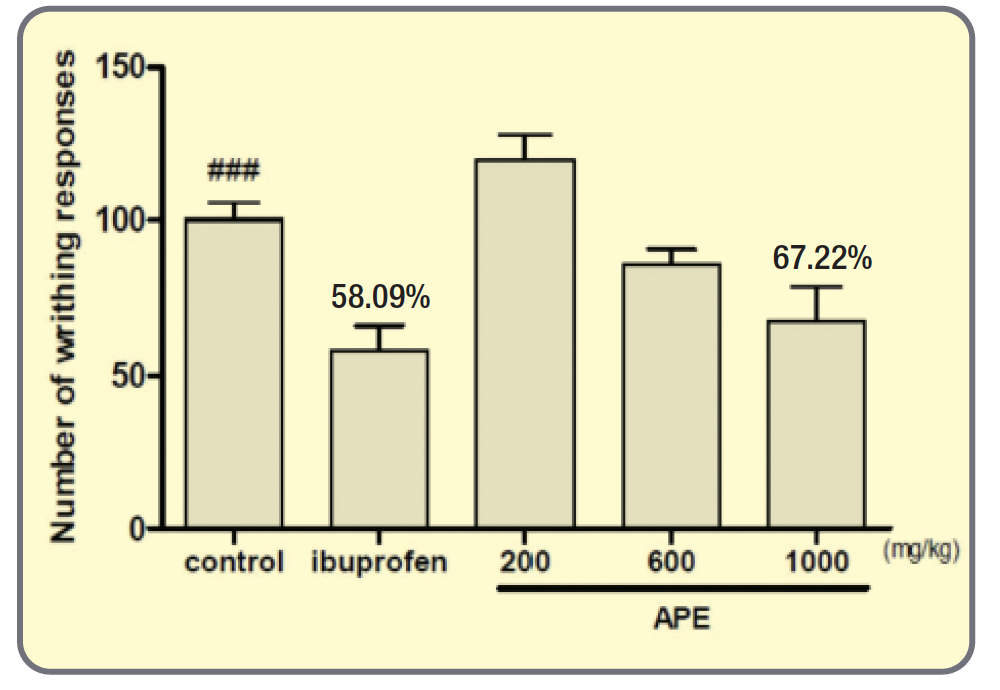
APE Suppressed Cytokines of IL-1β, IL-6, and TNF-⍺
Increased concentrations of pro-inflammatory cytokines are often found in the synovial fluids of OA patients. IL-1b is the key pro-inflammatory cytokine in OA, which stimulates the production of COX-2, iNOS, IL-6, and causes elevated production of Matrix metalloproteinase (MMP)s, which leads to cartilage erosion.
APE administrated rats had a significant reduction in the concentration of IL-1, IL-6, and TNF-⍺ in comparison with the control group. 300 μg/mL APE reduced the cytokine levels comparable to 1ug/mL of dexamethasone.
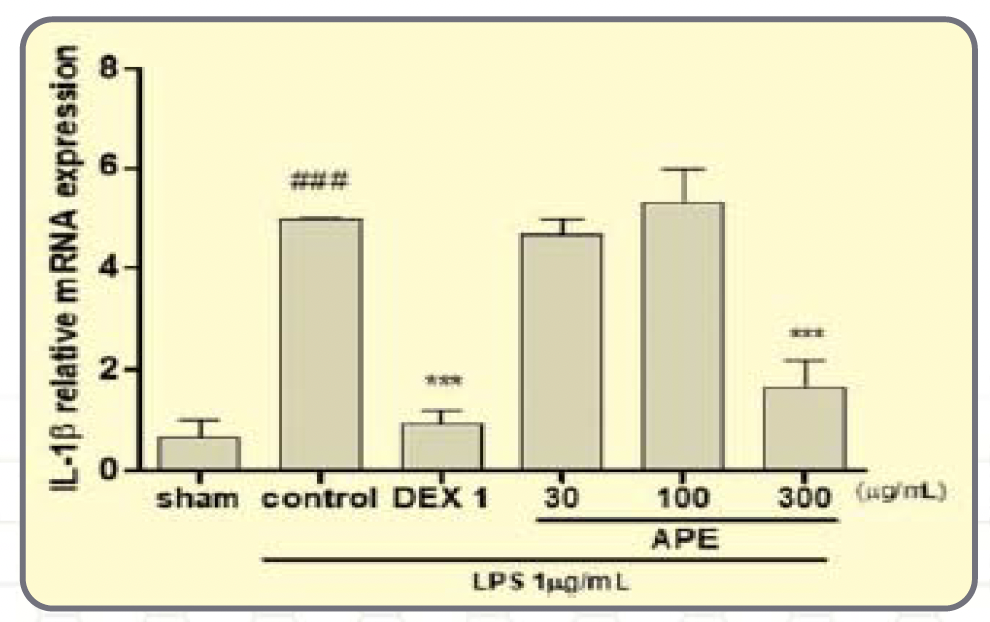
APE Reduced MMPs in Knee Joint Cartilage Tissue
MMP-1, MMP-8, and MMP-13 are the main collagenases that are distributed in synovial membrane. MMP-3 plays an important role in joint substrate degradation. APE resulted in a dramatic decrease in serum IL-1b and significant decline in MMP-1, MMP-3, MMP-8, and MMP-13 in knee cartilage tissues. 300 APE rats had lower levels of all four MMPs compared to indomethacin group.
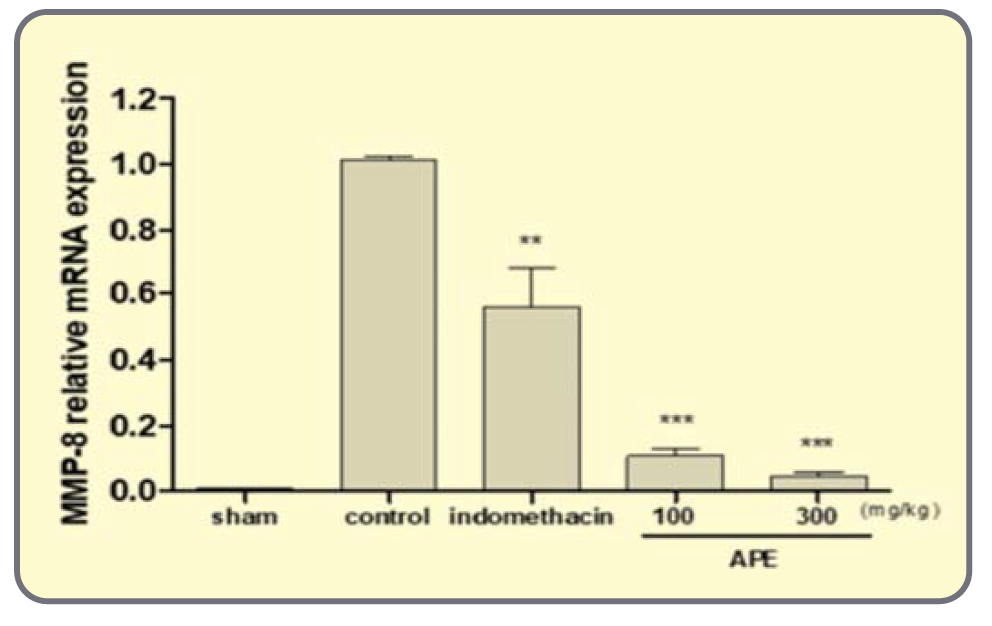
APE Suppressed iNOS, Nitric Oxide, and COX-2
The excessive amounts of COX-2 and iNOS in joints induce the production of pro-inflammatory cytokines and cause the destruction of cartilage, swelling, and pain. In LPS stimulated cells, 300 μg/mL APE suppressed the anti-inflammatory response by reducing the levels of nitric oxide, and the mRNA expression of iNOS and COX-2. Reduction of these cytokines by 300 μg/mL APE was comparable to 1ug/mL of dexamethasone.
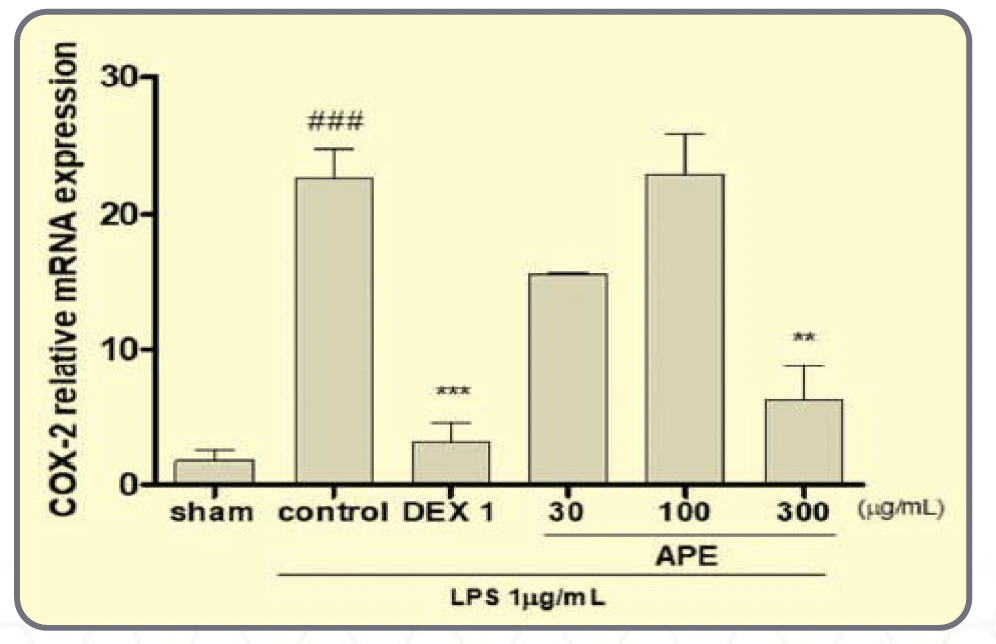
Andrographolide Relieved Pathological Pain Generated by Spared Nerve Injury Model in Mice
Central Nervous System glial cells have been found to play key roles in neuroinflammation and neuropathic pain. Allodynia is pain refers to pain that happens for no obvious reason. It may be linked to a range of nerve conditions, migraine, or fibromyalgia. Diclofenac is an NSAID used to treat pain, migraines, and arthritis. In this experiment, OP mice were subjected to peripheral neuropathy induced by sciatic nerve injury on the right paw.
Mechanical sensitivity was determined by measuring the withdrawal thresholds, and response percentage to von Frey hairs. The withdrawal thresholds of the right and left hind paw in the OP-Andro group were significantly higher compared with OP-saline group and OP-NSAIDs group. Andro reduced the neurological pain.
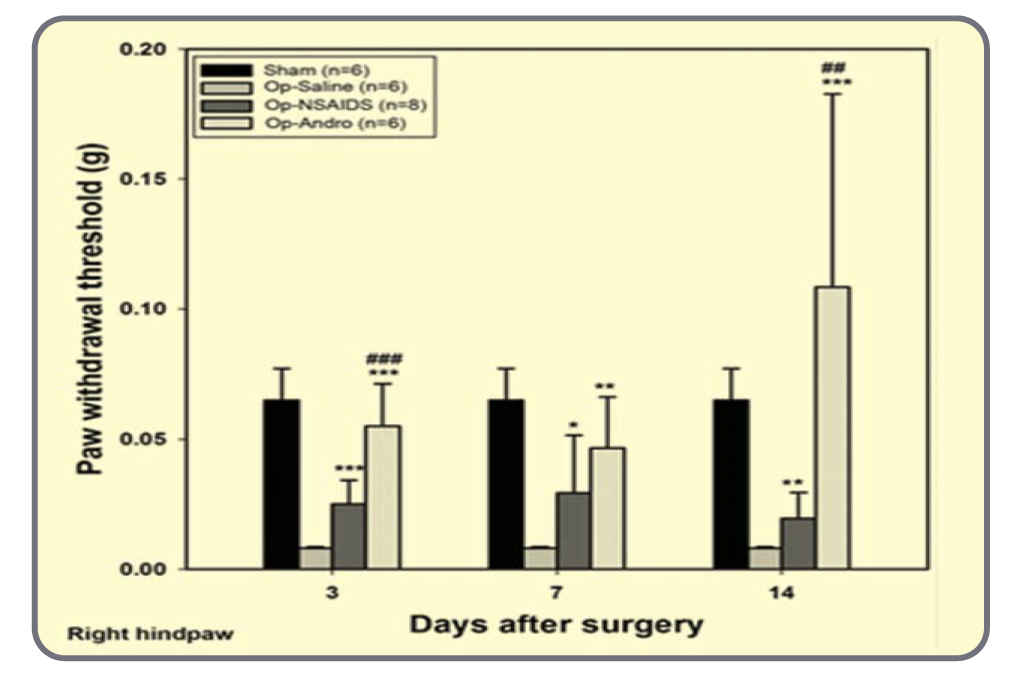
Andro Out-performed Diclofenac NSAIDS in Alleviating Nerve Pain & Mirror Pain
Left hind paw (non-operated) data suggested that Andro was more effective for alleviating centrally sensitized pain (mirror pain) than NSAIDS (diclofenac), especially at 7d and 14d.
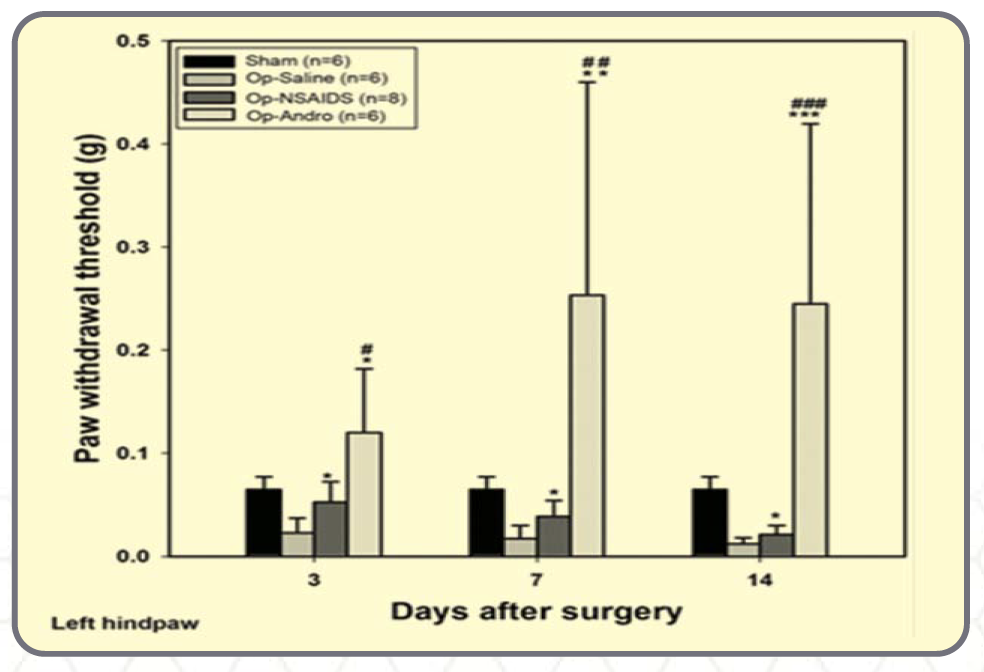
Andro Alleviates Nerve Pain & Mirror Pain Better than NSAIDS
- Op-Andro group showed lower response percentage than the OP-saline group
and the OP-NSAID group. Lower response rate indicates less mechanical allodynia.
Andro out-performed diclofenac NSAIDS
in reducing nerve pain and mirror pain.
- Andro reduced the neurological pain behavior.
- Andro showed increased threshold and decreased response percentage compared with the NSAIDS group.
- Central glial cells regulate the central sensitization of pain transmission. Andro acts as an NF-kB inhibitor, reducing IL-1 cytokines, and decreases COX-2 and inflammation-induced central PGE2 levels.
and the OP-NSAID group. Lower response rate indicates less mechanical allodynia.
Andro out-performed diclofenac NSAIDS
in reducing nerve pain and mirror pain.
ParActin® Natural Calcium Channel Blockers
Calcium channel blockers are medications used to lower blood pressure and have been a target for reducing neuropathy pain. Verapamil is a calcium channel blocker that has been shown to reduce nerve pain and can potentiate analgesic action of local anesthetics and reduce postoperative pain and analgesic consumption. In this experiment, KCl (40 mM) cause the depolarization of the membrane and opening of the voltage operated calcium channel. These lead to increased entry of Ca2 and the muscle contractility of the vas deferens smooth muscle in rats.
Andrographis paniculata (AP) selectively blocks voltage-operated calcium channels in rat vas deferens. 0.4mg/ml of AP and 1X10-7 M of Verapamil significantly reduced the KCl induced influx of 45Ca2, selectively blockades voltage-operated calcium channels (VOCs), hence inhibiting the 45Ca2 Influx, without affecting the response of norepinephrine.
HPI's Custom Formulations
HP Ingredients offers custom formulations and private labeling services to manufacturers. HPI’s innovation in formulations is accomplished by combining our trademarked ingredients with other clinically tested, well-researched nutraceuticals.
